Too late capitalism:
Does style become lost in immediacy?
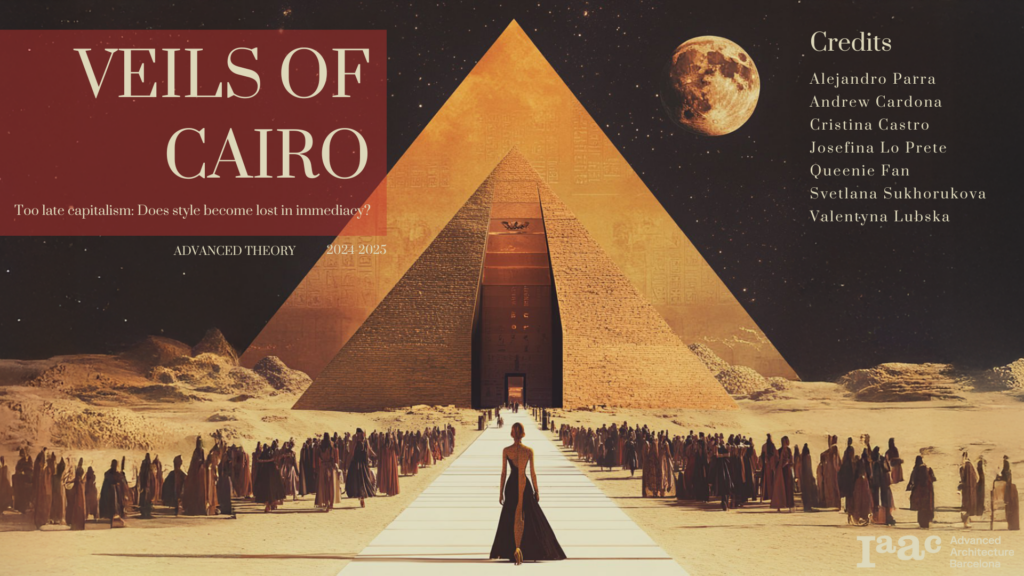
.
ACT ONE
It is late morning in the famous Khan el-Khalil market of Cairo, Egypt. (Fig 1) The air is filled with the aroma of the local spices and each stall is filled with different colors of fabric, textures and souvenirs. There is a steady hum of people conversing and vendors arguing. (Fig 2)
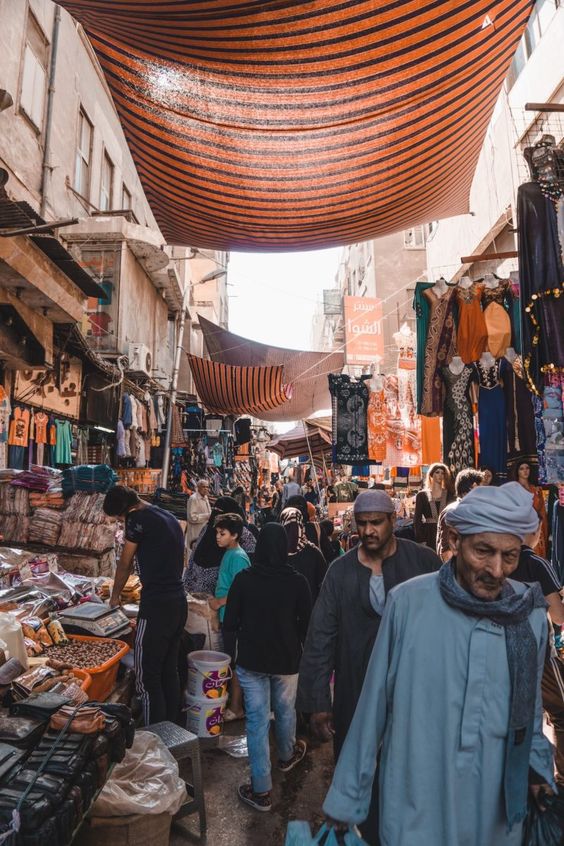
DESIGNER:
[facing the Model, the Designer points to the middle of the crowd]
Hey! Come stand here, I want to get a quick shot of this outfit with all the locals walking around you.
MODEL:
[the Model follows her instructions and stands in the middle of the street and begins posing for the photograph] (Fig 3)
This crowd is so overwhelming! Why did we have to do the shoot here again?
DESIGNER
Look, “we’re here to make art, but not in conditions of our choosing.” (1)
MODEL:
DESIGNER:
Your idea of art has an interesting style…
Style, funny you mention that.
[the Model ponders for a second]
The word style comes from the Latin word for pencil or pillar. “It denotes marks, the lineating that brings a thing into being.” (2)
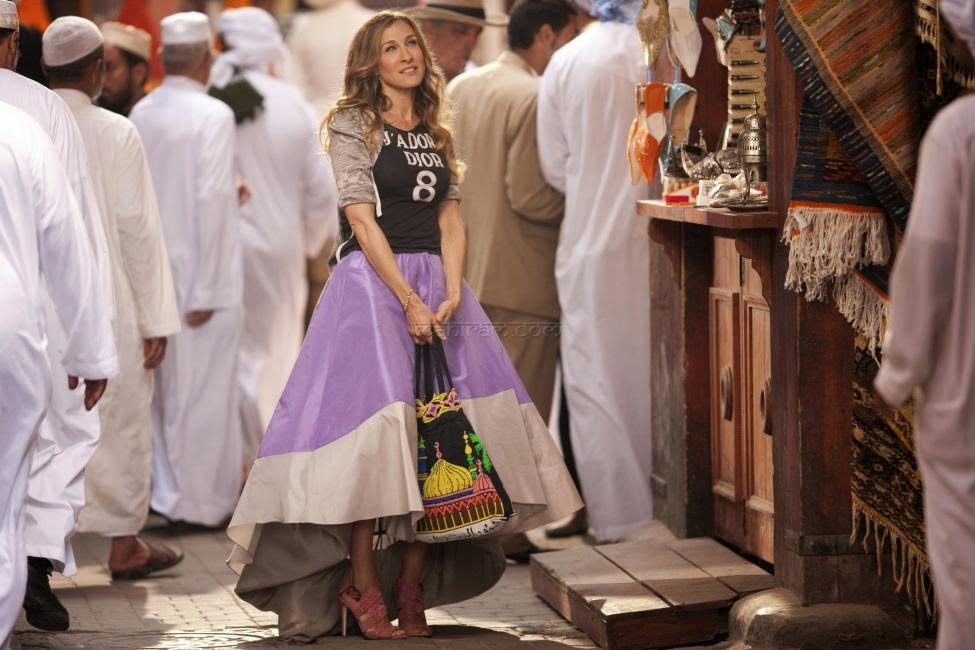
MODEL:
Well, you’re just describing where the word comes from. What does style mean as a concept?
DESIGNER:
Style “indicates deliberateness, exertion and target beyond the haphazard.” It also “marks the features of an event, era, text, or form as having been made.” Style connotes nothing other than action. (2)
MODEL:
.
DESIGNER:
.
MODEL:
.
.
DESIGNER:
I guess this fast-paced way of working is a style in itself then, especially in this too late capitalism.
Sure! We are in an intensified phase of capitalism where economic and cultural practices focus on the immediate. “The colloquial connotation of immediacy as “urgency” underlines the temporal dimension of this style, a hurry-hurry that compresses time into a tingling present.” (3)
.
Yeah makes sense. You’re saying that the purpose of this impromptu photoshoot is so that you can instantly share it on the brand’s social media pages, right? You know, get likes and share numbers up; make the campaign go viral.
.
Exactly! That’s the goal.
[the Designer snaps another shot of the Model and looks down at her iPhone and quickly edits the photo with a smoothing filter]
Okay, now come stand here in front of this stand and look to your left towards the Pyramids so I can get a shot of your profile.
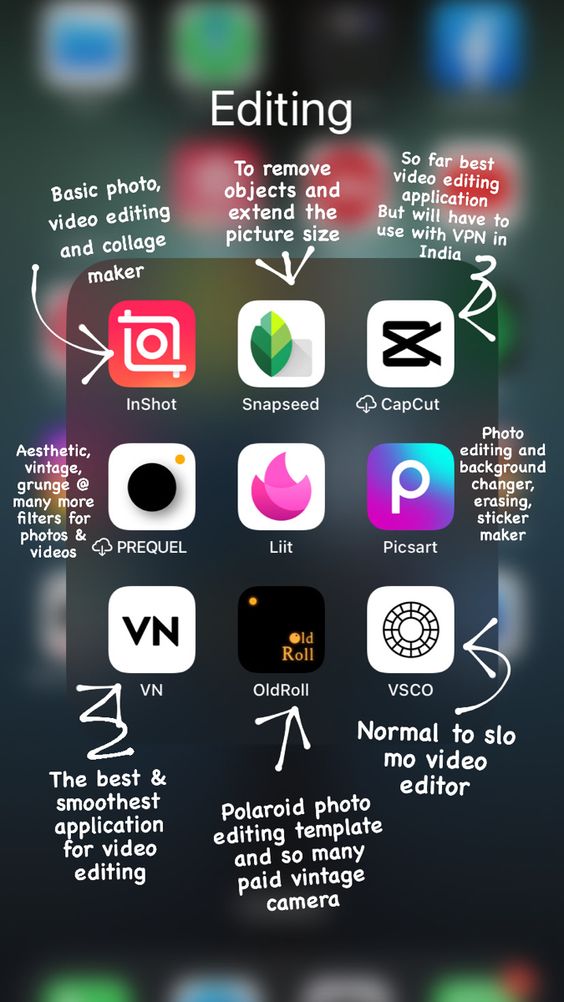
MODEL:
[the Model moves towards the merchant stand, but turns to look at the Designer]
Won’t the lighting look weird like this?
DESIGNER:
It’s fine, the AI software I use is making sure that all the photos we take have the same aesthetic. Besides, I downloaded a few photo apps that have a lot more camera controls that can help edit the photos to create whatever aesthetic I want. (4) (Fig 4)
The Designer and Model continue their unstaged photoshoot, moving back and forth along the bustling street of the market. A few stands away, the Director approaches a Vendor selling textiles; both of them are looking at the photoshoot happening in the middle of the street. (Fig 5)
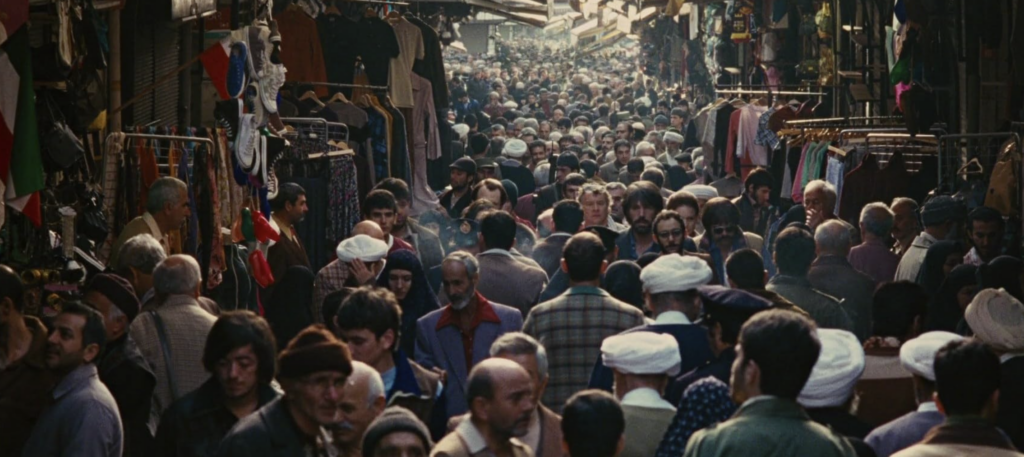
DIRECTOR:
[the Director turns to the Vendor]
Hello, how much for this fabric? (Fig 6)
VENDOR:
This one is 300 pounds.
DIRECTOR:
Ok, that’s a great price for such a beautiful piece! From its intricacy I can tell it was handcrafted with care.
VENDOR:
Yes, this piece has a long history, and that’s what makes it beautiful.
DIRECTOR:
.
.
.
VENDOR:
.
DIRECTOR:
[As the Vendor takes the fabric to wrap it up, the Director looks around and notices the Designer and Model doing their photoshoot and shakes his head in disdain]
This impromptu show, I can’t believe they call that fashion… You know, “immediatism is a reaction to crisis that fails the bar of strategy, a reflex that is ultimately crisis-continuous.” (5)
They have become too obsessive about capturing an image and have forgotten about narration. “Only with narration is life elevated above its sheer facticity, above its nakedness. Narrating means to make time’s passing meaningful, to give it a beginning and an end. Without narration, life is purely additive.” (6)
Narration doesn’t sell, people want a pretty picture, something smooth. I read somewhere that “smoothness defines what is beautiful.” It is a fundamental style of our times that signifies positivity. (7)
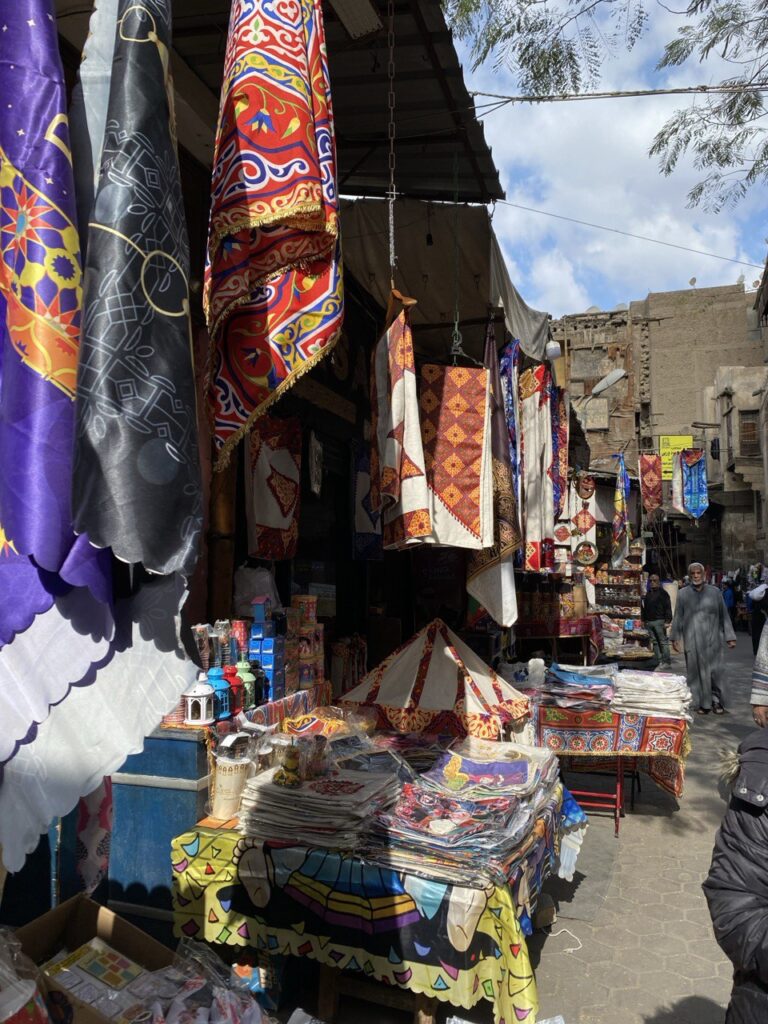
VENDOR:
Smoothness is overrated, look at this market, does it seem smooth to you?
DIRECTOR:
[the Director shrugs]
Not really.
VENDOR:
Yet, it is still beautiful, because it is our heritage, and when we lose our heritage, we “become impoverished. We have given up one portion of the human heritage after another.” (8) (Fig 7)
DIRECTOR:
VENDOR:
To me this just looks urgent, a “disastrous mechanization”, some “patience, distance, circumnavigation, prolonged attention would fix this.” (9)
.
You used the word mechanization, which is a type of mediation. There is clearly some order in the chaos. I come every day and set up my stand wherever I can, while still respecting the market’s layout.
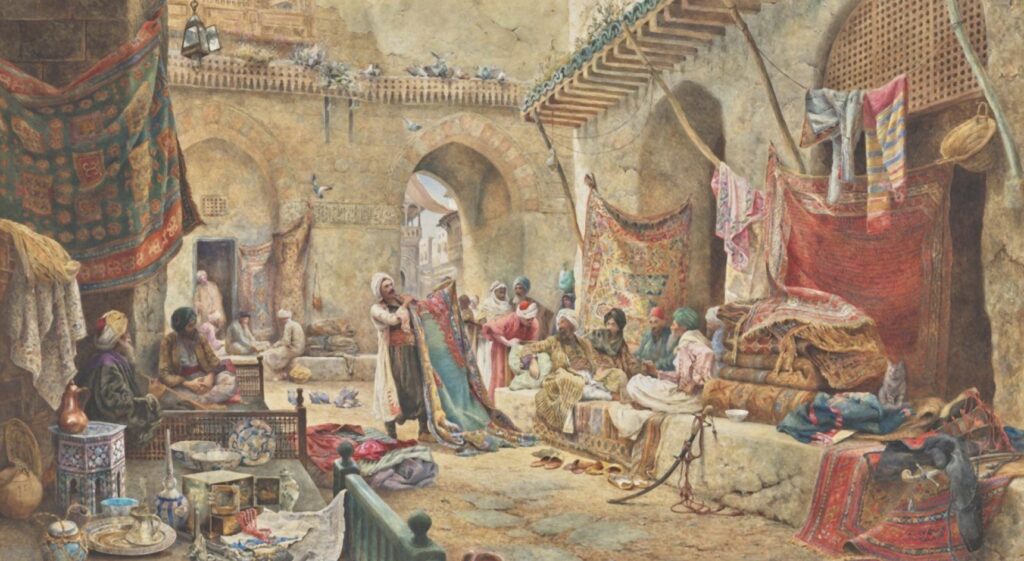
DIRECTOR:
It still seems too urgent, too random. There is no guarantee that you will sell fabric every day.
VENDOR:
When you put it that way, no.
DIRECTOR:
In a way you are “effectuating immediacy as architectural style, something flexible, modular.” (10) With the wave of a hand this could all be taken away.
VENDOR:
It is the hand that narrates that has the power of healing. (11) Contrary to the photoshoot, my stand is rooted in culture. I have done this for years and will continue for years to come.
The Director shrugs, takes his fabric and thanks the Vendor for his time. He looks at the Designer and the Model once more and shakes his head as he continues to another stall. He checks the time and realizes he must leave soon to prepare for his fashion show taking place tonight
.
ACT TWO
On the day of the Director’s fashion show, preparations are being made at a grand villa set against the Great Pyramids of Giza. The equipment and stage are being set up; the venue is starting to look sleek and smooth against the rough and sandy atmosphere. (Fig 8)
The Model walks into the venue as the Director gives out instructions to the crew setting up all the equipment for the fashion show.
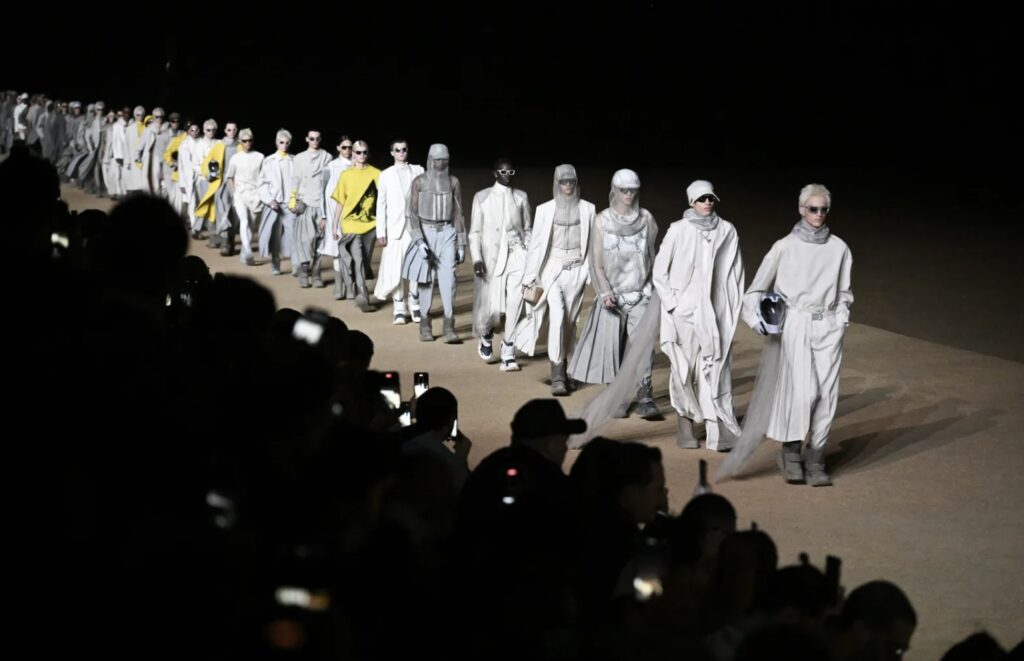
DIRECTOR:
[the Director sees the Model and approaches her]
Hey! Weren’t you at Khan el-Khalil market yesterday?
MODEL:
Hello! Yeah I was… How did you know?
DIRECTOR:
I was strolling around the market and saw you and that other girl taking photos.
MODEL:
Oh yeah, I was helping out my friend. She’s a local designer and we were getting some photos for her social media campaign.
DIRECTOR:
[the Director shakes his head in contempt while sighing]
“Beauty has lost its aura and has become immediate, stripped of any aura that might slow us down and compel us to linger.” (12)
MODEL:
I think that “in the digital age, the artwork’s aura is not lost but redefined through its online presence.” (13) There’s value in the accessibility of art in the media.
DIRECTOR:
“The more directly accessible things are, the more they lose their value. Beauty loses its aura through overexposure.” (14)
MODEL:
[the Model looks at the Director in disagreement]
I’m not sure that’s the case… I find that there’s something quite beautiful about being able to share your art as you’re making it. It keeps things real and authentic.
DIRECTOR:
.
.
.
MODEL:
.
.GGGGGGGGGGGGGGGGGGGGGG
DIRECTOR:
“Beauty used to invite contemplation, but now it’s engineered for instant gratification. Our aesthetic sensibilities are flattening.” (15) Your style is so focused on the “immediate” these days. It’s all about Instagram posts and Tik Toks, we’ve lost the notion of curating the art we create.
.
Immediacy precipitates blur and negates mediation to effect flow and indistinction. I tend to align myself with the postmodernists, who revel in mediation, the intertextuality, irony and the meta, where we can activate the pastiche. (16)
.
[the Director contemplates the Model’s words for a second and slightly nods his head]
Ok, I can see that your style still has some mediation. I guess you’re right, we do live in an age where technology and social media are very prevalent in our day-to-day lives. Our brand is clearly also on social media, but we do believe that the content shared online should also be meticulously thought out.
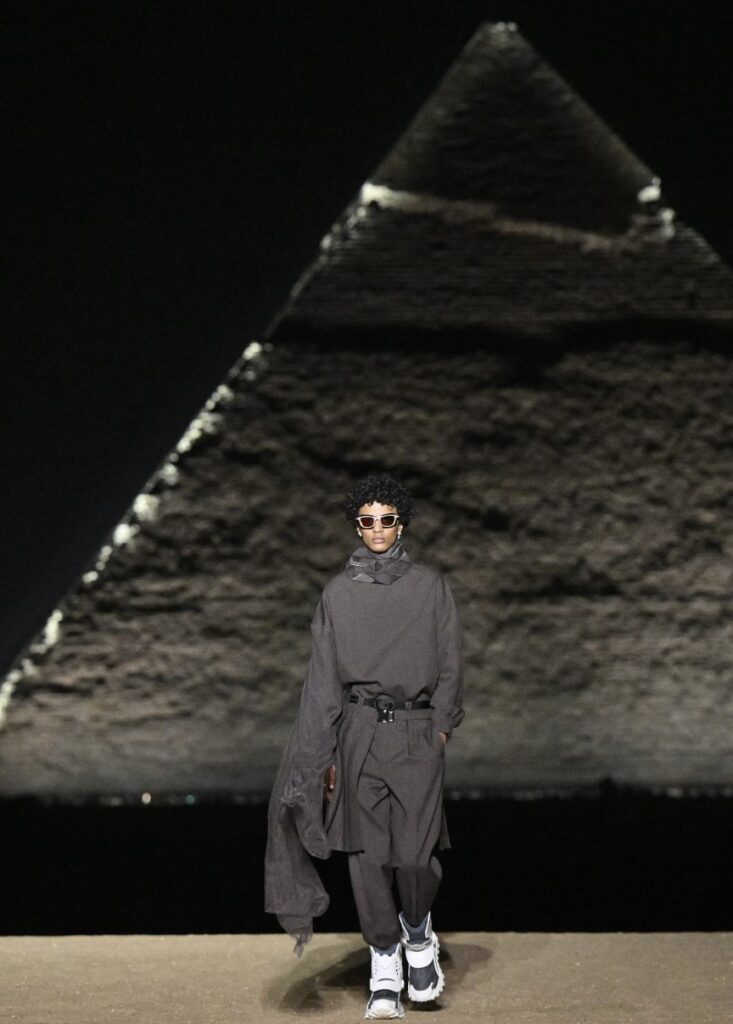
MODEL:
Totally! I think we’re on the same page. Our styles just vary in our approach.
.
ACT THREE
As the final look exits the runway (Fig 9), a distinguished Fashion Critic in the audience rises and makes his way over to the Director, eager to share his thoughts on the evening’s presentation. (Fig 11)
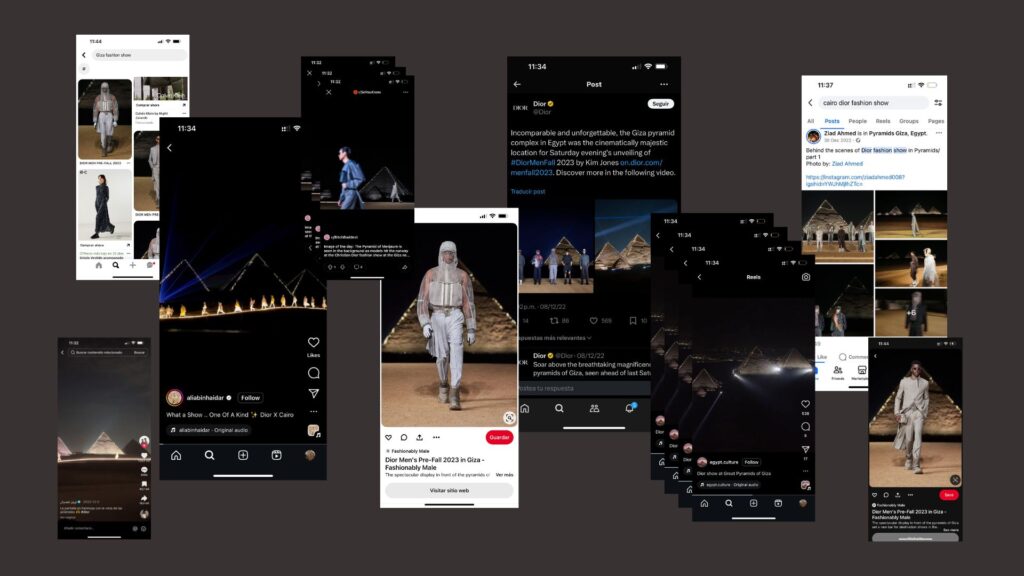
CRITIC:
Congrats! What a great show!
DIRECTOR:
Thank you, that means a lot coming from you.
CRITIC:
I thought it was especially powerful set against those Pyramids, what was your inspiration for that?
DIRECTOR:
The site is so powerful, and my vision was to “evoke the social process of making representation, connections, and meaning, in other words, to make middles that merge extremes.” (17)
.
.
.
DESIGNER:
.
.MMMMMMMMMMMMMMMMMMM
CRITIC:
The Designer, who was also in the audience, congratulates her friend, the Model. They overhear the Critic and the Designer, both important figures in the fashion world, talking about the show and approach them to join the conversation. (Fig 12)
.
[the Designer reaches her hand to greet the Director and the Critic]
Hi, it’s nice to meet you both! I had some thoughts on the show I’d love to share with you.
.
Hey! It was great, right? We were just talking about the amazing setting. Although, I’m wondering whether the show even needed to be here, by the Pyramids?
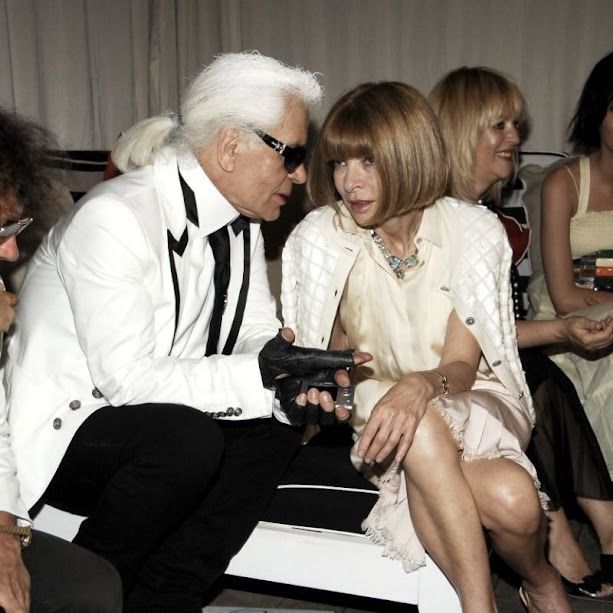
DESIGNER:
I think the same effect can be reached way more efficiently. We have access to technologies that allow us to create incredible things without going through all the logistics. Besides, with social media it can be shared in an instant.
CRITIC:
That’s one perspective, but it’s pure immediacy. The paradox of your “immediacy” is that it’s a cultural style that imagines itself unstyled. (18)
DIRECTOR:
Immediacy cannot be a style. Mediation, on the other hand, is still emerging quietly on the edges of contemporary aesthetics, subtle but influential. (19)
CRITIC:
The problem is that you only favor smoothness in your mediation. You’re not addressing the cultural context your photoshoot is in. It’s merely a backdrop.
DIRECTOR:
Ha! Funny you mention that, yesterday this vendor was telling me that “Only with narration is life elevated above its sheer facticity.”
CRITIC:
.MMMMMMMMMMMMMMMMMM
MODEL:
MMMMMMMMMMMMMMMMMM
CRITIC:
That’s a very old fashioned way to look at style, especially nowadays that we have so many resources at our disposal.
.
I don’t think it’s about one or the other, it is possible to layer the elements that best suit a concept, while maintaining their clear boundaries.
.
Oh, I see the post-modernist in you… I don’t think you can call it a style though. Sure, you’re layering a bunch of different styles together, but does that make the whole a style in itself?
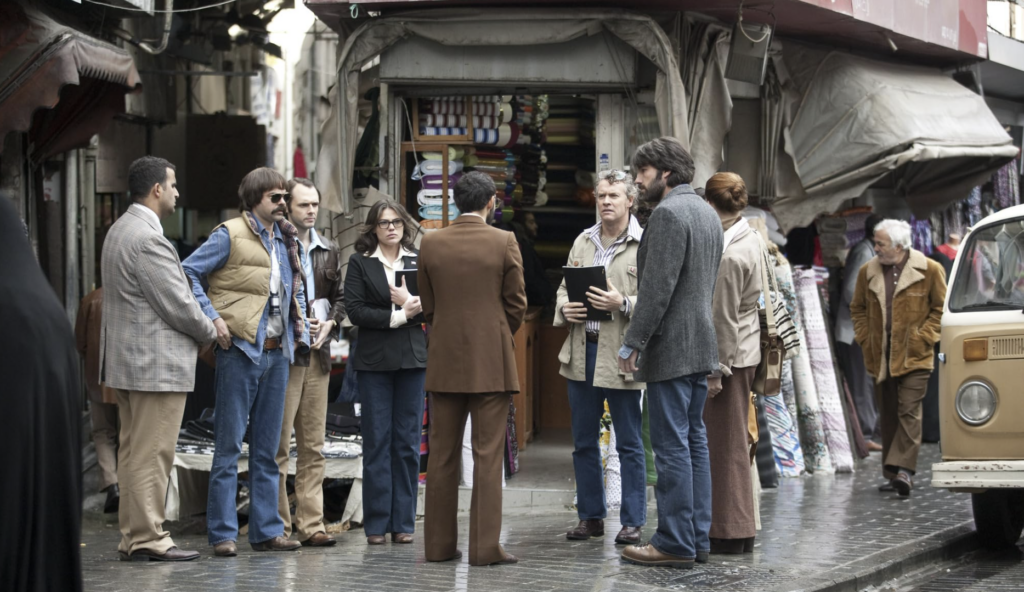
MODEL:
Ok, if immediacy, smoothness, narratives and postmodernism aren’t styles, then what’s a style for you?
CRITIC:
As you can see… All of you have expressed extremely different cosntraints for style. We live in a contemporary time where style is no longer useful to index the constraints of aesthetics.
DIRECTOR:
Excuse me guys. I need to take this zoom call, but we should definitely continue this conversation…
TO BE CONTINUED…?
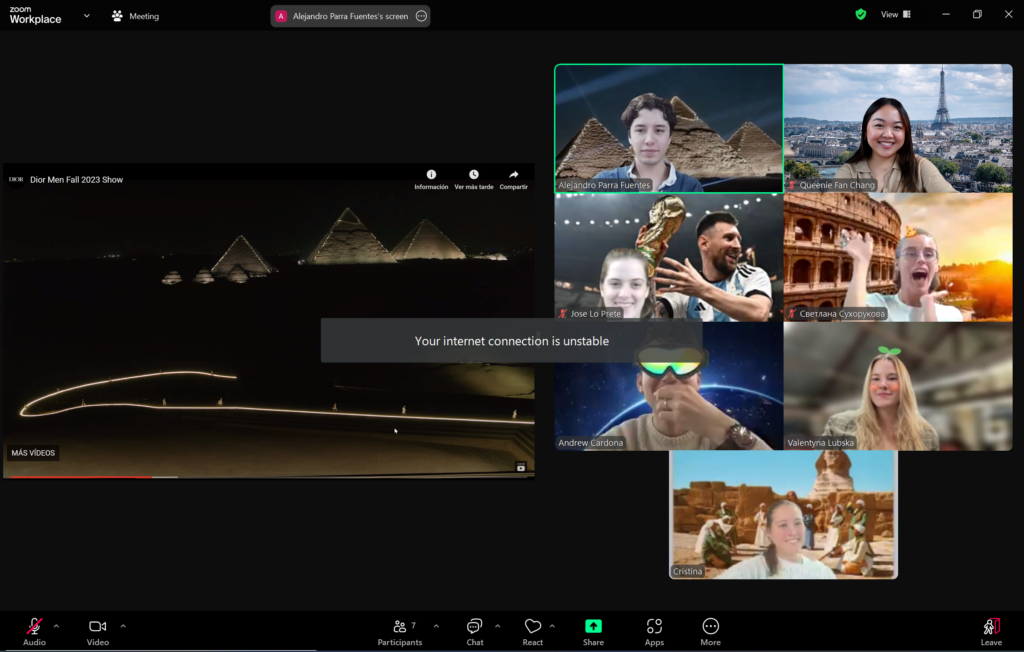
Quotes
- Kornbluh, Anna, “Immediacy, or The Style of Too Late Capitalism”, 9.
- Kornbluh, Anna, “Immediacy, or The Style of Too Late Capitalism”, 8.
- Kornbluh, Anna, “Immediacy, or The Style of Too Late Capitalism”, 5.
- Manovich, Lev, “AI Aesthetics”, xx.
- Kornbluh, Anna, “Immediacy, or The Style of Too Late Capitalism”, 17.
- Han, Byung-Chul, “The Crisis of Narration”, 36.
- Han, Byung-Chul, “Saving Beauty”.
- Han, Byung-Chul, “The Crisis of Narration”, 24.
- Kornbluh, Anna, “Immediacy, or The Style of Too Late Capitalism”, 17.
- Kornbluh, Anna, “Immediacy, or The Style of Too Late Capitalism”, 33.
- Han, Byung-Chul, “The Crisis of Narration”, 62.
- Han, Byung-Chul, “Saving Beauty”.
- Groys, Boris, “In The Flow”, 42.
- Han, Byung-Chul, “Saving Beauty”.
- Han, Byung-Chul, “Saving Beauty”.
- Kornbluh, Anna, “Immediacy, or The Style of Too Late Capitalism”, 13.
- Kornbluh, Anna, “Immediacy, or The Style of Too Late Capitalism”, 4.
- Kornbluh, Anna, “Immediacy, or The Style of Too Late Capitalism”, 10.
- Kornbluh, Anna, “Immediacy, or The Style of Too Late Capitalism”, 19
Bibliography
Kornbluh, Anna. Immediacy, or The Style of Too Late Capitalism. Verso Books, 2024
Han, Byung-Chul. The Crisis of Narration. Translated by Daniel Steuer, Polity Press, 2024.
Han , Byung-Chul. Saving Beauty. Translated by Daniel Steuer, Polity Press, 2017.
Groys, Boris. In the Flow. Verso Books, 2016.
Manovich, Lev. AI Aesthetics. Strelka Press, 2018.

